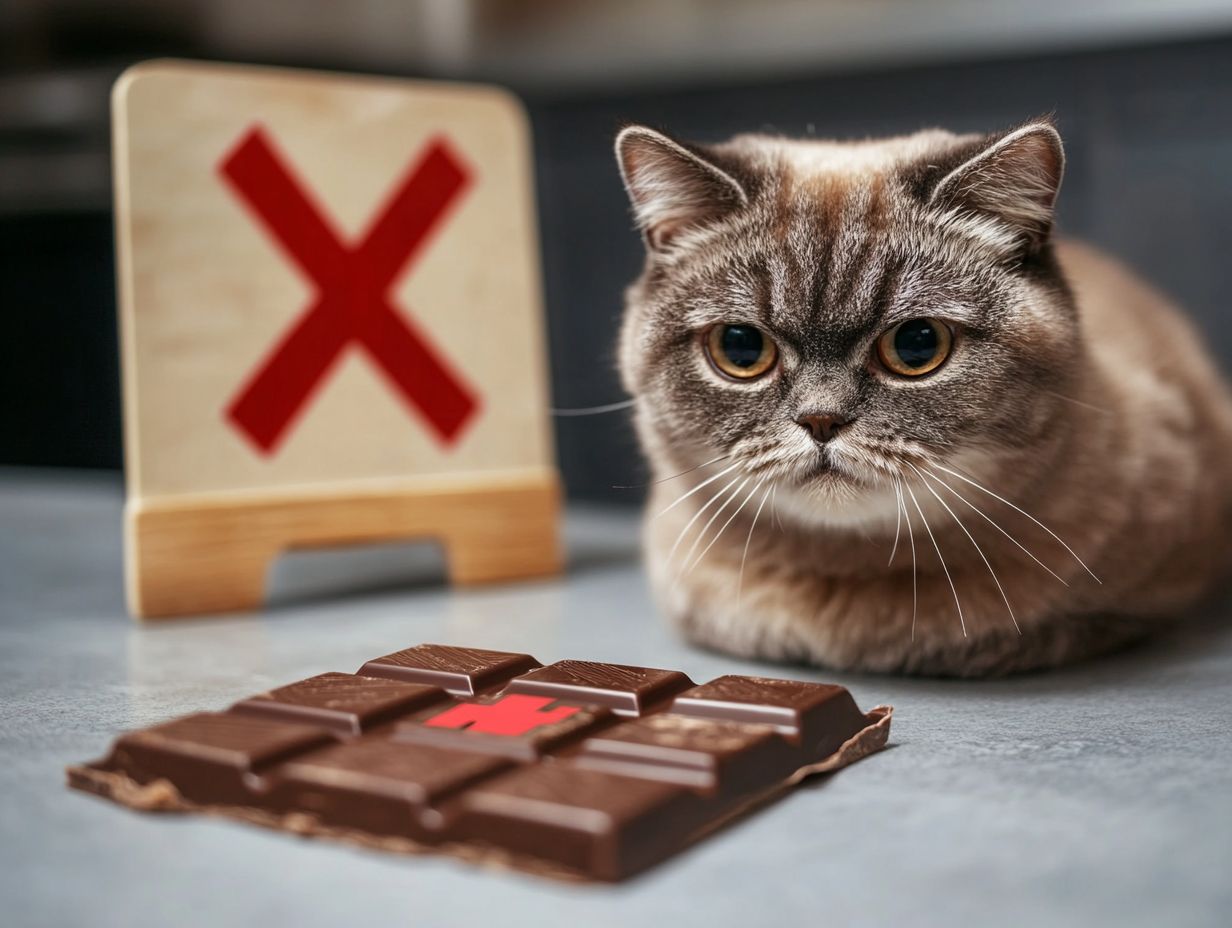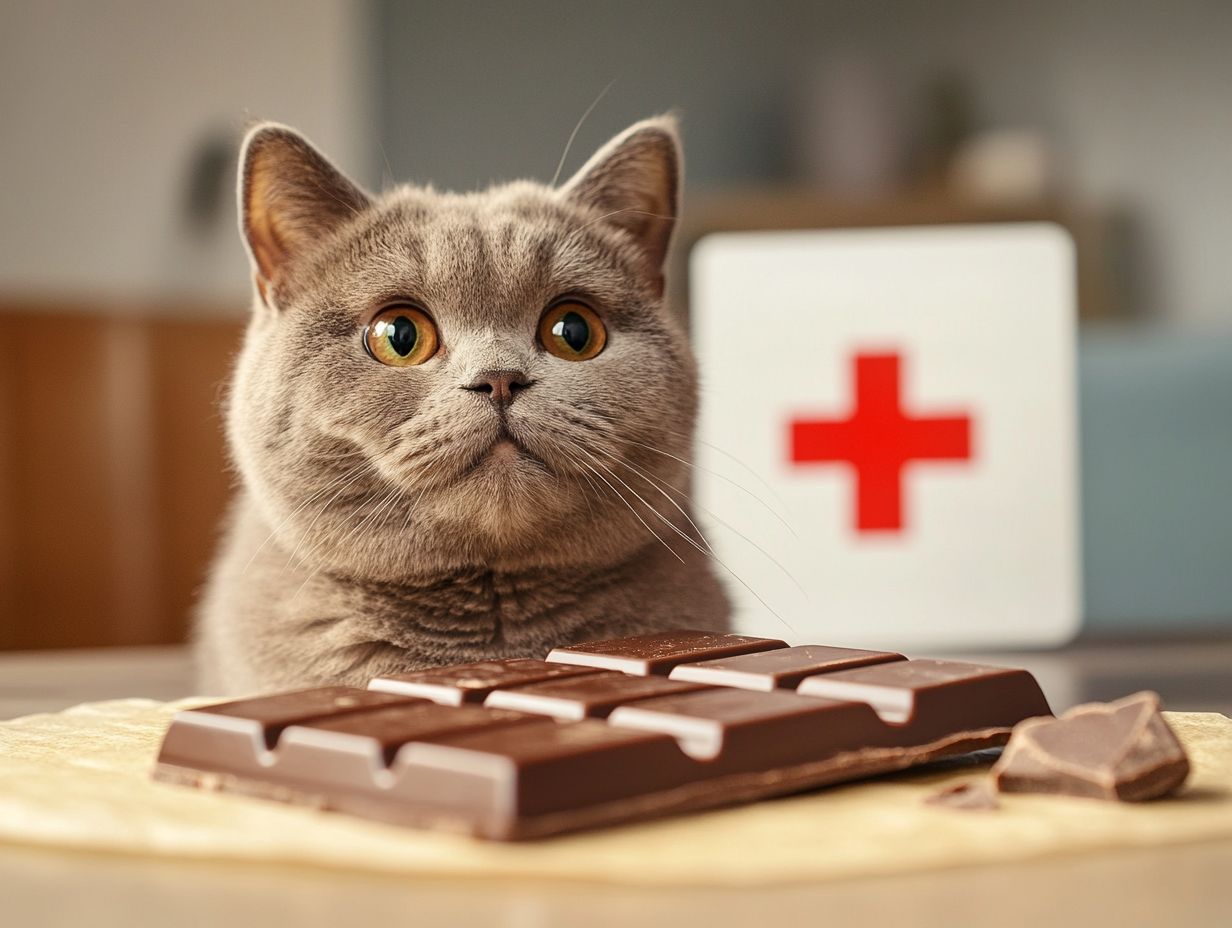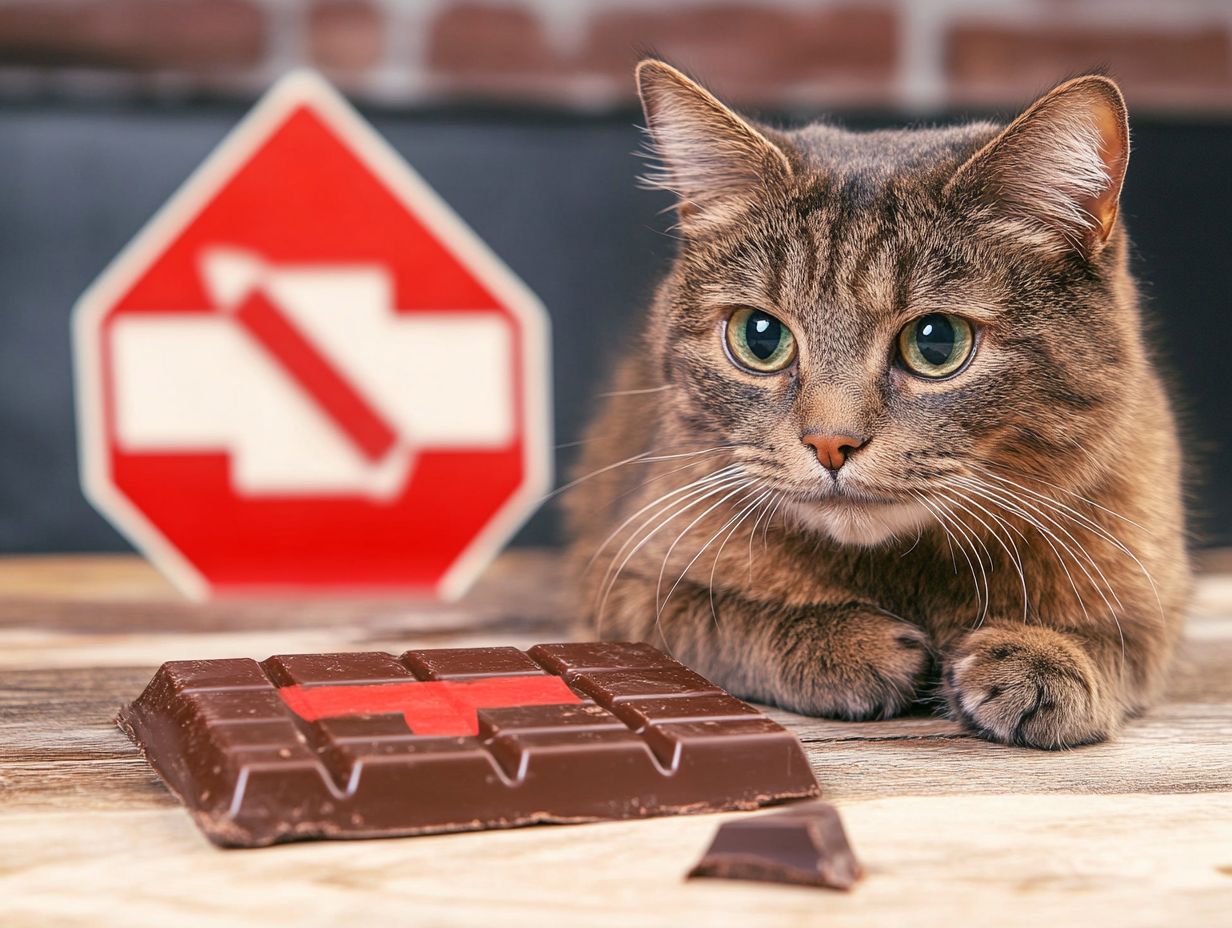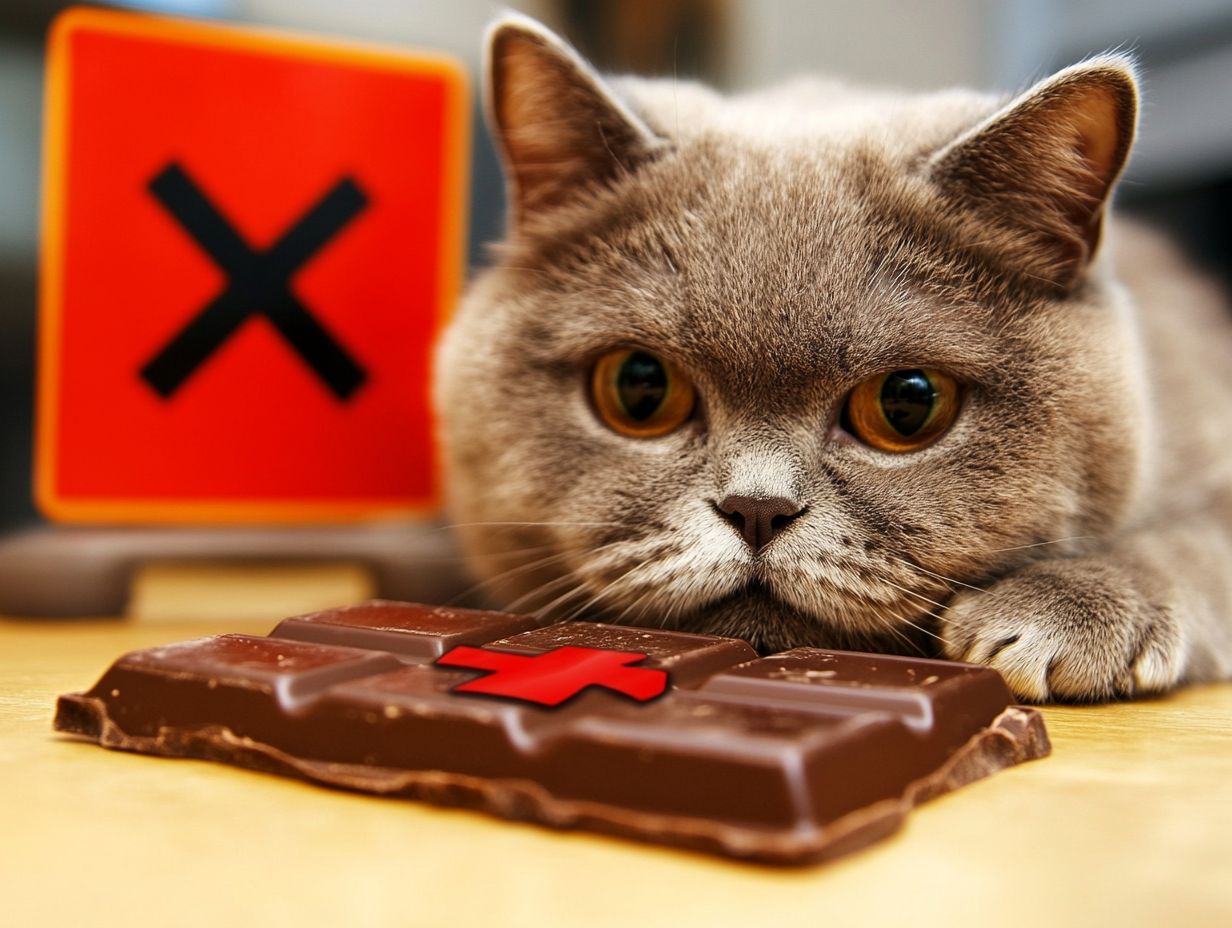Chocolate is a well-known danger for cats, and understanding its effects is crucial for every cat owner. Cats are curious creatures, often getting themselves into trouble when it comes to exploring their environment—especially when it involves food. Their inquisitive nature can sometimes lead them to consume harmful substances.
One seemingly harmless treat, chocolate, poses serious dangers to our feline friends, as it is highly toxic.
We discuss the risks of chocolate consumption in cats, recognize the symptoms of chocolate poisoning, and outline essential treatment steps. Understanding the health risks associated with chocolate can help prevent severe poisoning cases. Tips for keeping chocolate safely out of reach and delicious, safe alternatives to satisfy your cat’s cravings will also be shared. Pet care starts with awareness of these dangers.
Key Takeaways:

- Chocolate is toxic for cats and should never be given to them as it can cause serious health issues.
- If your cat shows symptoms of chocolate poisoning, seek immediate veterinary care. Common symptoms include vomiting, increased heart rate, restlessness, and seizures.
- Prevention is key when it comes to keeping cats safe from chocolate. Always keep it out of reach and consider safe treat alternatives for your feline friend. Pet parents should be vigilant, especially during holidays like Christmas, Halloween, Valentine’s Day, and Easter.
Understanding Chocolate Toxicity in Cats
Cats should never eat chocolate, as it is toxic and can lead to serious health issues. Chocolate—especially Baker’s chocolate, dark chocolate, and semi-sweet chocolate—contains theobromine and caffeine, both of which are highly toxic to cats. Many studies show that chocolate is dangerous for cats, with reliable sources like Frontiers in Pharmacology and agencies such as Pet Poison Helpline as well as the ASPCA.
It is crucial for all cat owners to be aware of these dangers, particularly since chocolate is often given as treats during holidays like Christmas, Halloween, Valentine’s Day, and Easter. If a cat is suspected of having ingested chocolate, it is essential to contact a veterinarian immediately. For more information about the risks, check out this article on the dangers of chocolate for cats, as prompt action can prevent severe poisoning and potentially save the cat’s life.
The Dangers of Chocolate for Cats
Chocolate can be dangerous for cats due to a compound called theobromine, which can be harmful in high doses. Theobromine is present in varying amounts across different types of chocolate. Dark chocolate and unsweetened baking chocolate contain the highest concentrations, posing a greater risk than milk chocolate or white chocolate, which contains virtually no theobromine. For more insight on the topic, you might refer to USA TODAY and PetMD.
Even low doses can lead to adverse reactions in cats, as they lack the enzymes necessary to metabolize theobromine. Symptoms of chocolate toxicity in cats include:
- Vomiting
- Diarrhea
- Increased heart rate
- Tremors
- Seizures
Therefore, it is crucial for pet owners to exercise caution and monitor their pets closely. Chocolate should be stored out of reach of pets to minimize the risk of accidental consumption.
Symptoms of Chocolate Poisoning in Cats
Symptoms of chocolate poisoning can include severe physical reactions such as:
- Vomiting
- Diarrhea
- Increased heart rate
- Restlessness
- Hyperactivity
This makes it essential for cat owners to closely monitor their pets.
Identifying and Addressing Symptoms

Identifying and treating the symptoms of chocolate poisoning in cats is crucial for ensuring they receive veterinary care promptly, which increases their chances of a positive outcome. Cat owners should remain vigilant for signs of chocolate poisoning, as even small amounts of chocolate can be toxic to cats. If you see any urgent signs, contact a poison control center or your veterinarian immediately.
Prevention and Safe Alternatives
To prevent chocolate poisoning, always store chocolate in high cabinets and out of reach of pets. Consider opting for safe treat alternatives like freeze-dried chicken or fish to satisfy your cat’s cravings.
Conclusion
In summary, chocolate is a significant health risk for cats, and awareness of its dangers is paramount for every cat owner. If you suspect your cat has ingested chocolate, contact your veterinarian immediately for guidance.
- Key Points:
- Chocolate is toxic to cats; avoid all types.
- Monitor for symptoms like vomiting and tremors.
- Store chocolate safely out of reach.
- Consult your vet for safe treat alternatives.
Can cats eat chocolate? The simple answer is no. Chocolate contains theobromine, a compound toxic to cats, which can lead to serious health issues. Symptoms of chocolate consumption may include changes in behavior, such as restlessness or tiredness, increased urination, tremors, and seizures. Even a small amount of dark chocolate can be harmful to cats. If these or other concerning symptoms occur, cat owners should first assess how much chocolate has been consumed and the type of chocolate involved. Dark chocolate has a significantly higher concentration of theobromine compared to milk chocolate. For more information, check out this article on Can Cats Eat Chocolate? Dangers and Risks Explained.
Owners should then contact their veterinarian or a poison control center immediately. If you suspect chocolate poisoning in your cat, do not wait for symptoms to worsen.
Treatment for Chocolate Poisoning in Cats
Treatment for chocolate poisoning in cats occurs at a veterinary clinic, where veterinarians can accurately diagnose the problem and provide appropriate care. This may include inducing vomiting or administering activated charcoal, but this should only be done under veterinary guidance to mitigate the harmful effects of chocolate on the cat’s body.
Steps to Take in an Emergency
In case of chocolate poisoning in cats, there are several crucial steps to follow:
- Evaluate the situation: The first step is to thoroughly evaluate the situation by observing any signs of distress in the cat, such as vomiting, diarrhea, or restlessness. Consider the type and amount of chocolate involved.
- Contact a veterinarian: Next, contact a veterinarian immediately, as they can provide guidance tailored to the specific circumstances of the exposure. Be sure to communicate the type and amount of chocolate consumed, as different varieties contain varying concentrations of theobromine, the toxic component.
- Prepare for emergencies: Having emergency contact numbers readily available can facilitate timely assistance for pet owners, increasing the chances of a swift recovery for their beloved companions. Ensure you have the contacts for your vet, a poison control center, and an emergency veterinary clinic.
Preventing Chocolate Poisoning in Cats
Pet owners must take measures to prevent chocolate poisoning in cats. These actions can significantly reduce the chances of accidental ingestion and the associated health risks. Pet parents should be particularly careful during festive seasons when chocolates are commonly present.
Tips for Keeping Chocolate Away from Cats

Implementing effective strategies to keep chocolate away from cats is essential for their safety. Here are some guidelines for proper chocolate storage:
- Whenever possible, use child-proof containers to limit access, and place these containers in secure locations that are regularly checked and updated as needed. Hills Pet Nutrition recommends considering the mobility and agility of your pets when choosing storage places. Cats are known for their agility and climbing abilities, so it’s crucial to choose storage places that consider their mobility.
Additionally, maintaining open communication with family members and neighbors about the dangers chocolate poses to pets can significantly reduce the risk of accidents in the household. Providing simple reminders can effectively promote awareness and help prevent potential mishaps.
Alternatives to Chocolate for Cats
The best chocolate alternatives for cats are those that do not contain theobromine, a compound found in chocolate that is toxic to them. These alternatives should be safe for pets and pose no harm to their health. Always consult your veterinarian before introducing new foods to your cat’s diet.
Safe and Healthy Treat Options
To help ensure your cat’s safety, here are some guidelines summarizing safe and unsafe human foods for cats:
- Safe options: Cooked chicken, turkey, and certain fruits like blueberries and cantaloupe.
- Unsafe options: Chocolate, onions, garlic, and grapes.
In conclusion, chocolate can be extremely harmful to cats, and prevention is key. Always consult a veterinarian for any dietary concerns and remain vigilant about what your pets have access to in your home.
When it comes to ensuring the health and happiness of your feline friend, selecting safe cat treats is crucial. These treats can include a variety of commercially available products and homemade options that are not only appealing but also beneficial for their health. It’s important to choose treats that support your cat’s nutrition while avoiding harmful ingredients. For further guidance on cat nutrition, sources like Purina, Hills Pet Nutrition, and PetMD can be very informative. Always consult with your veterinarian about the best food options for your cat’s well-being.
Freeze-dried meat treats are an excellent choice, high in protein (often around 60-90% protein content) and free from artificial preservatives. These treats offer a concentrated source of nutrients, making them a great supplement to your cat’s diet. Catnip-infused treats not only provide mental stimulation but can also aid in digestive health by promoting a sense of calm. Regularly incorporating these safe treats can enhance your cat’s overall health while pampering them at the same time.
When selecting treats, cat owners should read labels carefully. Look for options that do not contain fillers or excessive additives. Moderation is key; overfeeding treats can lead to obesity and other health issues. A general guideline is to limit treats to no more than 10% of your cat’s daily caloric intake. For example, if your cat weighs 10 lbs and requires approximately 200 calories per day, treats should not exceed 20 calories.
- Ingredients to Avoid:
- Artificial preservatives – can cause health issues over time.
- Fillers like corn and soy – offer little nutritional value.
- High sugar content – can lead to obesity and diabetes.
- Safe Alternatives to Chocolate:
- Small amounts of cooked chicken or turkey.
- Commercial cat treats specifically formulated for felines.
To summarize, it is essential to choose safe cat treats that align with your cat’s nutritional needs. Always consult your veterinarian for personalized dietary recommendations, and be vigilant about avoiding toxic foods for cats, such as chocolate. Remember, prevention is key to keeping your pet healthy and happy!
Frequently Asked Questions
Can Cats Eat Chocolate?

No, cats should not eat chocolate. Chocolate contains theobromine, which is toxic to cats and can cause serious health problems.
What are the dangers of cats eating chocolate?
Theobromine in chocolate can cause vomiting, diarrhea, increased heart rate, seizures, and even death in cats. It can also lead to pancreatitis, a potentially life-threatening inflammation of the pancreas. Emergency care is essential in such cases to mitigate the health risks.
Are all types of chocolate dangerous for cats?
Yes, all types of chocolate contain theobromine and can be toxic to cats. However, the darker the chocolate, the higher the level of theobromine, making it more dangerous for cats to consume. Always monitor your pet for any signs of poisoning if chocolate is suspected to have been ingested.
How much chocolate is toxic for cats?
The amount of chocolate that is considered toxic for cats depends on their weight and the type of chocolate. As a general rule, any amount of chocolate can be dangerous for cats and should be avoided. It’s important for pet owners to keep chocolate, specifically Theobroma cacao products, away from their pets.
What are the signs of chocolate poisoning in cats?
If your cat has ingested chocolate, look out for symptoms such as vomiting, diarrhea, tremors, increased heart rate, and restlessness. Increased urination and hyperactivity are also common signs. If you notice any of these signs, contact your veterinarian immediately.
What should I do if my cat has eaten chocolate?
If your cat has consumed chocolate, such as Dark Chocolate, Milk Chocolate, or Baker’s Chocolate, it is important to seek veterinary care right away. Your vet may induce vomiting and provide supportive care to prevent further complications. Do not try to treat your cat at home without consulting a professional at Chimacum Valley Veterinary Hospital or by contacting the Pet Poison Helpline. Keep away chocolate during holidays like Christmas, Halloween, Valentine’s Day, and Easter to protect your pet.